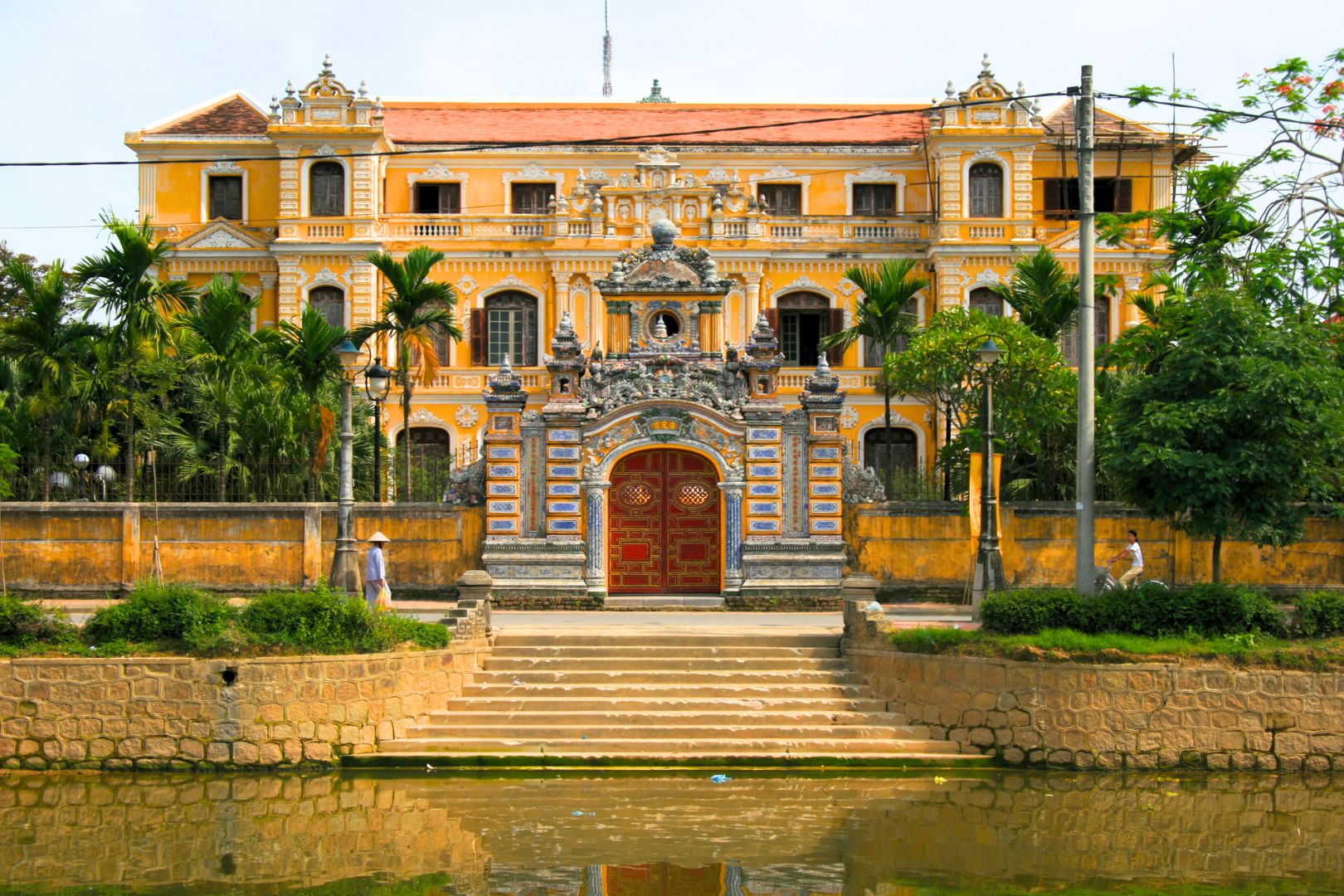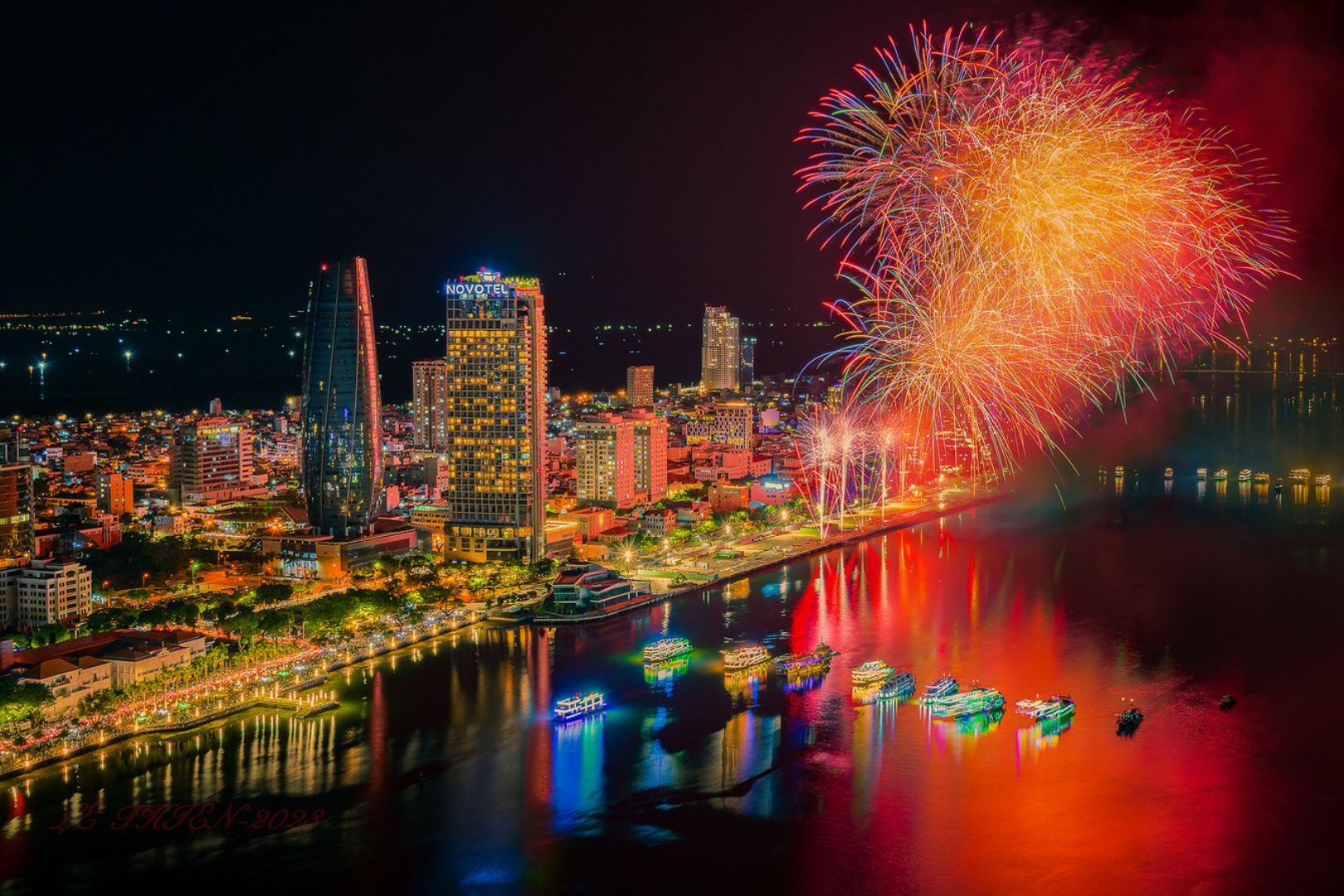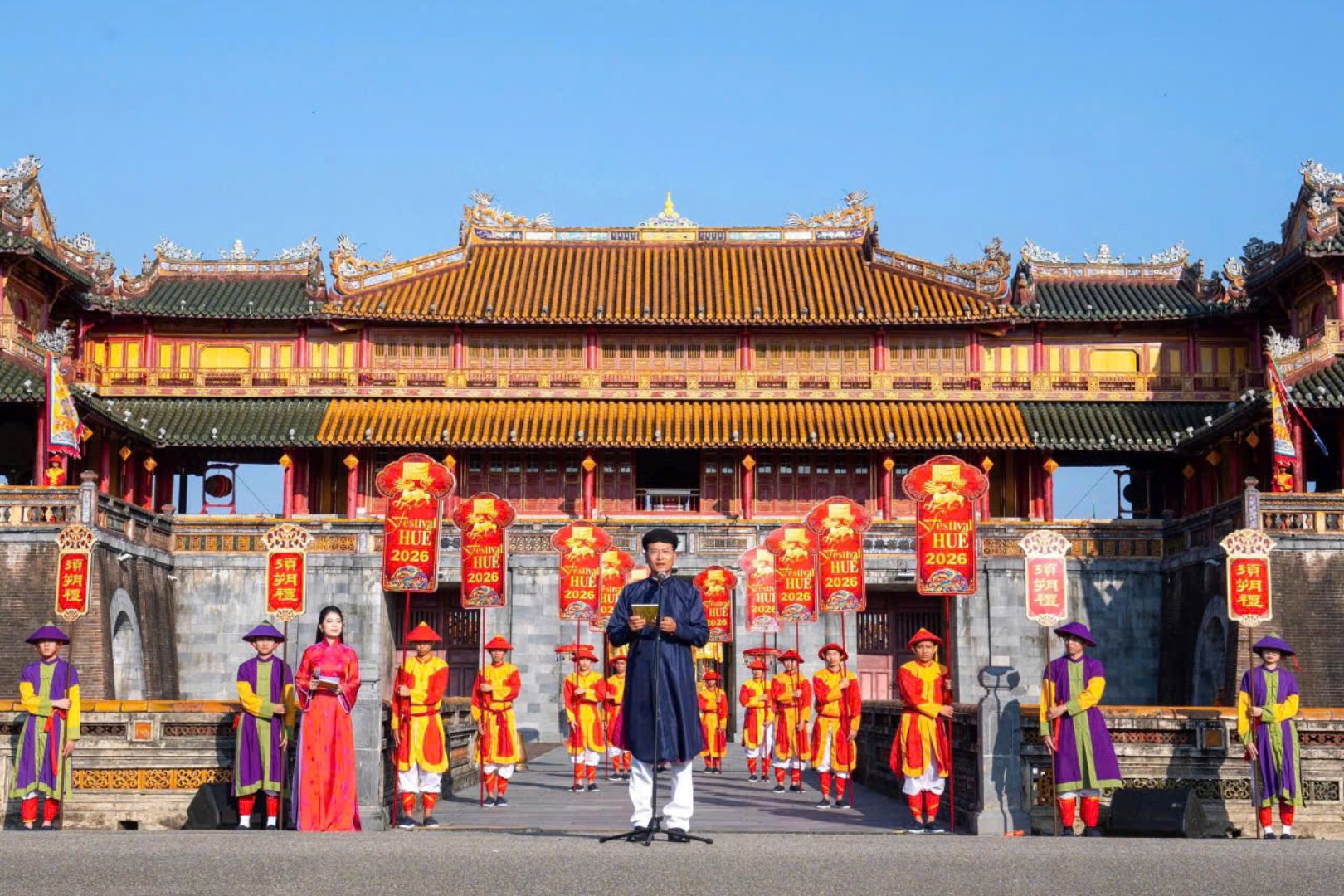Index
Hue is a former imperial capital steeped in time and tradition. With its quiet, dignified heritage sites, the city continues to captivate travellers seeking beauty and history. Amidst this rich historical tapestry, An Dinh Palace stands out as a masterpiece of architecture. This historic site not only witnessed the lives of the last two emperors of Vietnam but also showcases a fascinating fusion of Eastern and Western art. Let Laguna Lang Co guide you through the elegance and significance of An Dinh Palace – a must-visit highlight on any Hue travel itinerary
Introducing An Dinh Palace – A Hue Travel Landmark
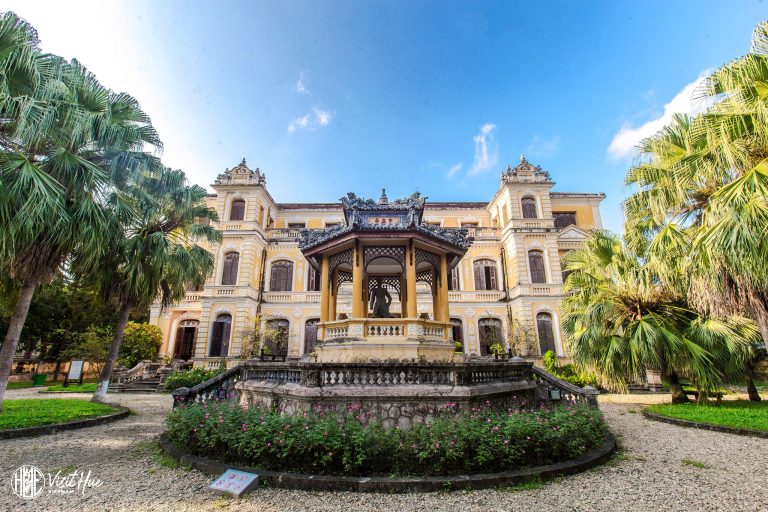
Location: 179 Phan Dinh Phung Street, Phu Nhuan Ward, Hue City
Opening Hours: 07:00 – 17:00 daily
Admission Fee: VND 50,000/person
An Dinh Palace (安定宮) once served as the private residence of Emperor Khai Dinh, from his days as Crown Prince until his ascension to the throne. Emperor Bao Dai later inherited it, living there until his abdication.
Situated by the tranquil An Cuu River, the palace was originally located in De Bat Ward, but now sits in central Hue on Phan Dinh Phung Street. For this reason, many consider it a valuable historical monument and a key destination on any Hue travel route.
According to Wikipedia, An Dinh Palace is part of the greater Complex of Hue Monuments but lies outside the main Imperial Citadel. Furthermore, this area is also home to other famous landmarks, such as Thien Mu Pagoda, Gia Long’s Tomb, and Minh Mang’s Tomb – each contributing to the cultural and historical depth of Hue.
The Historical Footprints of An Dinh Palace
As history tells, in the 14th year of the Thành Thái reign (1902), the future Emperor Khải Định, then Phụng Hóa Công, commissioned a private residence. He named this place An Dinh Residence, thereby creating a personal living space separate from the formal court.
In 1917, he decided to completely renovate the residence. He ordered the old structures dismantled and replaced them with new buildings in a distinctive Western style. Following this grand renovation, he renamed the residence An Dinh Palace, which covered a total area of 23,463 square metres. It later became the home of Crown Prince Vĩnh Thụy, who would become Emperor Bảo Đại – the last emperor in the history of the Nguyen Dynasty.
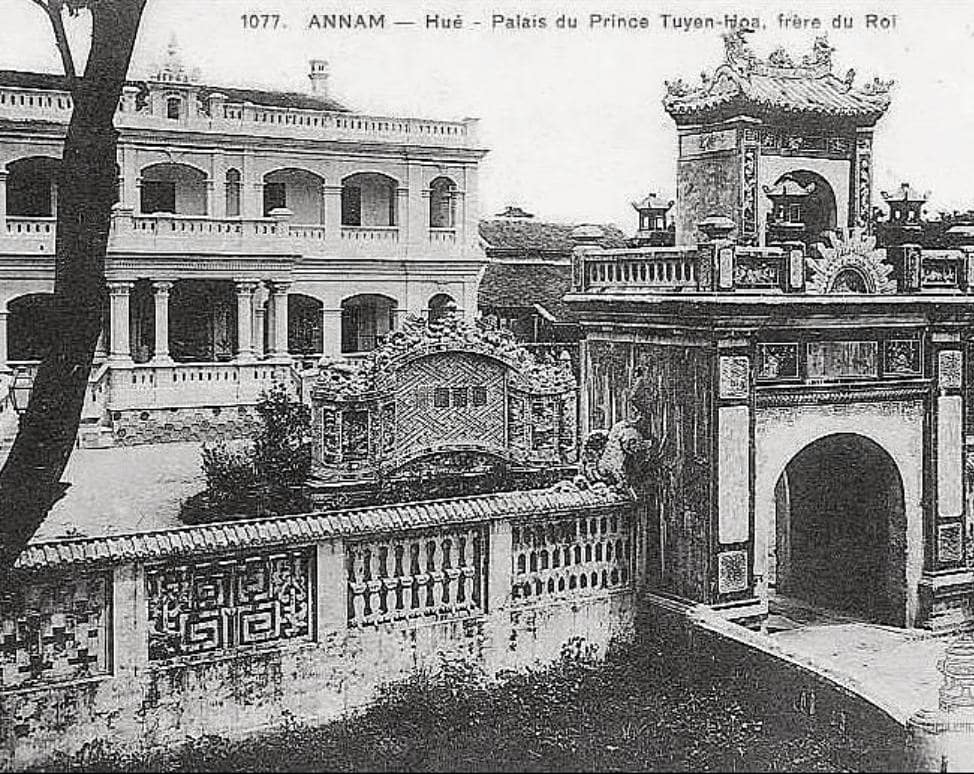
Explore the unique architecture of An Dinh Palace on your Hue travel journey
In its prime, the palace complex featured around ten buildings. Today, only three main structures remain open to visitors: the Main Gate, Trung Lap Pavilion, and Khai Tuong Tower.
Main Gate (Cua Cung): The two-storey entrance gate is built sturdily from brick. It makes a powerful impression with its elaborate, raised ceramic and porcelain mosaic decorations, particularly the exquisitely crafted winding dragons and phoenixes.
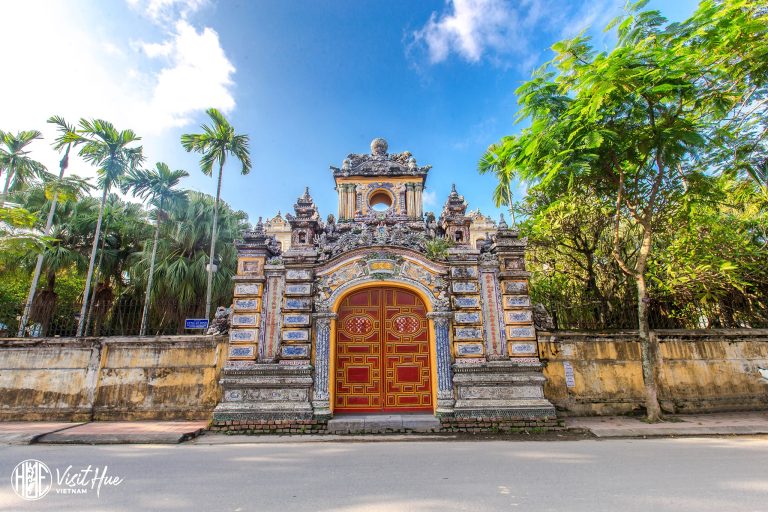
Trung Lap Pavilion: Located at the centre of the complex, Trung Lap Pavilion has a unique octagonal structure set on a high platform. Its roof is intricately decorated with 12 sculpted dragons. Inside stands a life-sized bronze statue of Emperor Khải Định, exquisitely cast in 1920.
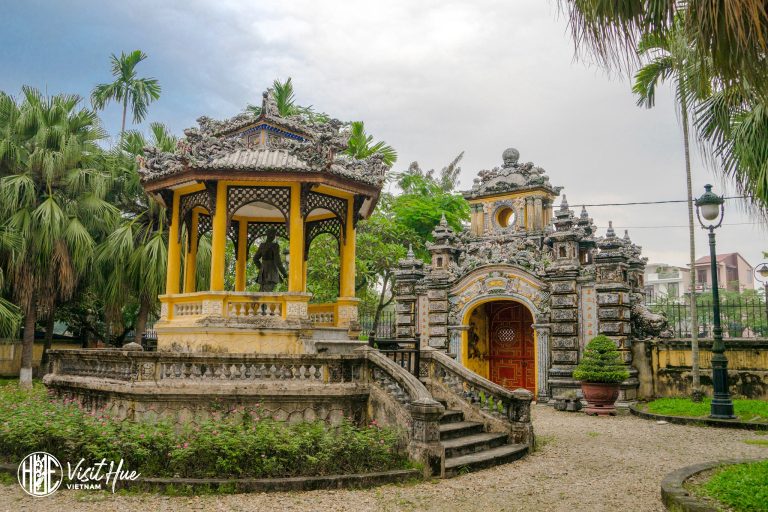
Khai Tuong Tower: Inspired by European castles, Khai Tuong (meaning “Auspicious Beginnings”) is a grand three-storey structure with 745m² of floor space. Its golden facade is elegantly contrasted with white details, evoking royal sophistication.
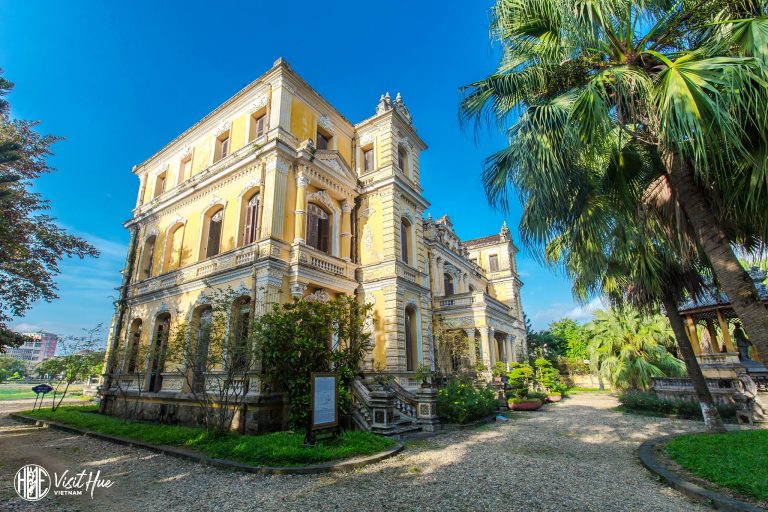
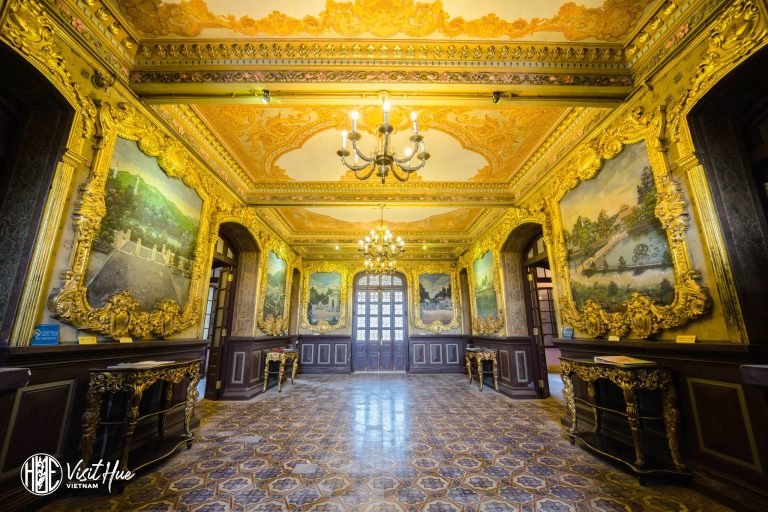
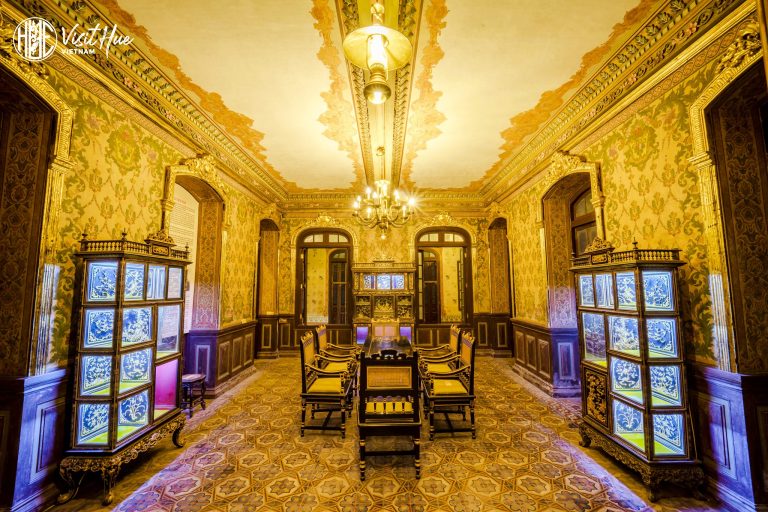
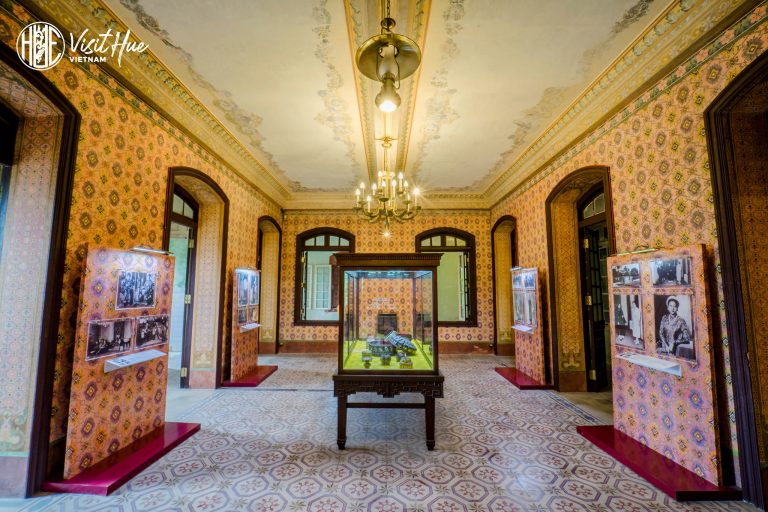
Unmissable Experiences at An Dinh Palace – Hue Travel Tips
Explore Historical Traces and the Former Royal Living Quarters at An Dinh Palace
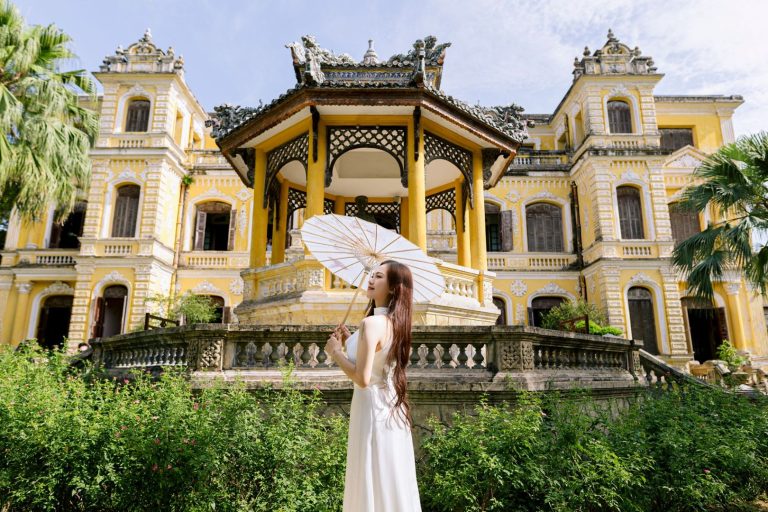
When you visit An Dinh Palace as part of your Hue travel itinerary, you will feel as though you have stepped back in time. The palace preserves many vivid details of royal life, from the functional areas within the building to documents recounting the lives of the emperors and empresses.
A particular highlight here is the seamless fusion of Eastern and Western architecture. Every interior detail was designed with sophistication and luxury in mind: from the chandeliers and French-imported door handles to the grand, bifurcated staircase in a distinctly European style. It all combines to create an atmosphere that is both elegant and regal.
Make sure to visit Cuu Tu Dai, the royal family’s private theatre, which once hosted exclusive cultural performances.
Admire the Splendour of Khai Tuong Tower at An Dinh Palace

Khai Tuong Pavilion is the area that attracts the most visitors. The building has been painstakingly restored with the support of German experts. Today, a total of 22 rooms, both large and small, are open for public viewing.
Cinematic Check-In at Camellia Garden (Bach Tra Vien) at An Dinh Palace
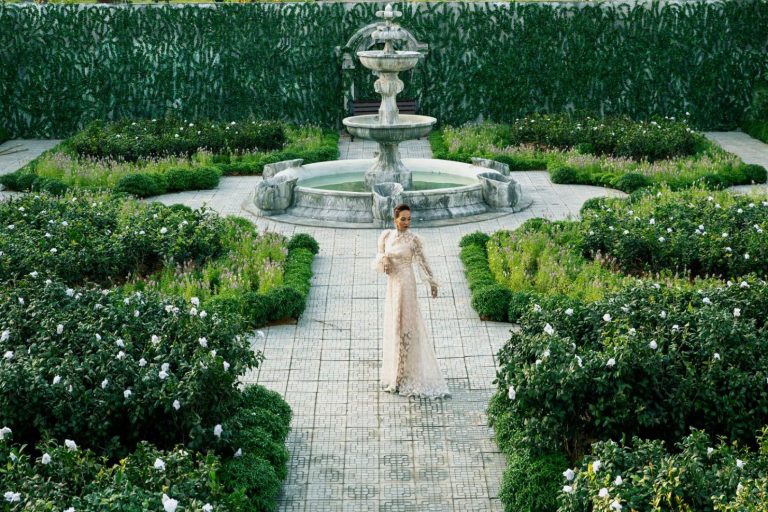
More than just a historical monument, An Dinh Palace is an incredibly impressive spot for photos, offering a classical and artistic backdrop. The meticulously maintained grounds are lush and green, creating a striking contrast against the time-honoured yellow of the palace architecture. Here, you can capture frames that are both poetic and classic.
A standout feature not to be missed is Bach Tra Vien (Camellia Garden). This beautiful garden was a filming location for the movie “Gái già lắm chiêu V” (The Last Egg 5). The romantic beauty of this spot will surely provide the perfect background for your Hue travel photos.
Nearby Attractions Worth Exploring on Your Hue Travel Journey
Hue Imperial City
No trip to Hue would be complete without visiting the Hue Imperial City. This is a vast architectural complex that preserves the essence of the Nguyen Dynasty. The architecture of the Imperial City reflects the majesty and splendour of a golden era. Despite the vicissitudes of history, it still stands strong, sheltering countless unique works of art. Exploring this site will give you a deeper sense of the cultural and historical depth of the ancient capital.
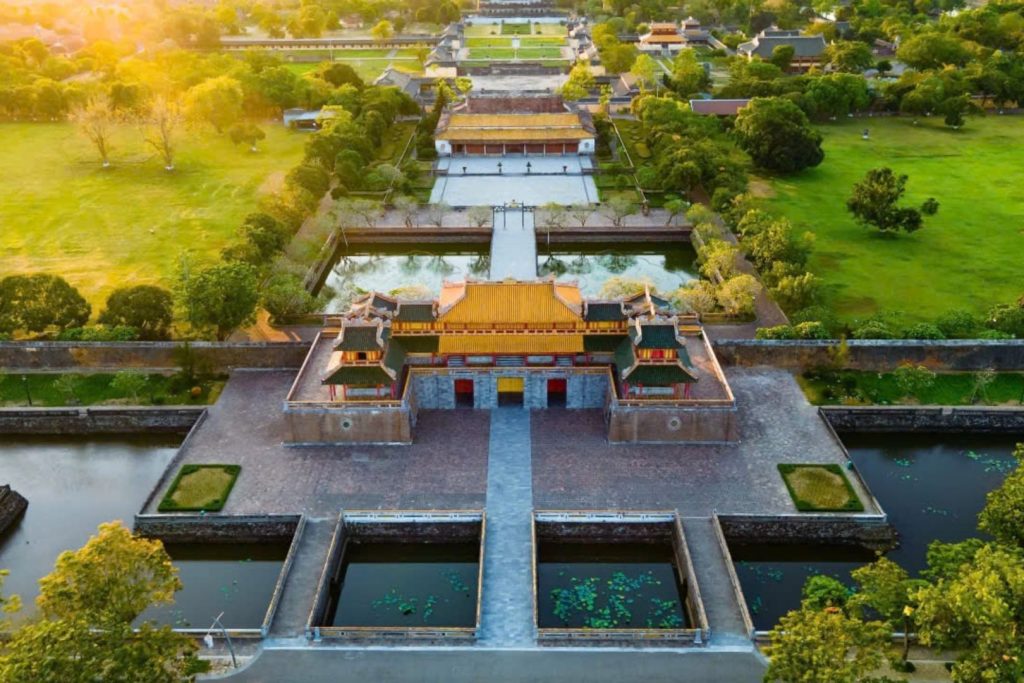

Thien Mu Pagoda
Following the Perfume River northward, visitors will find Thien Mu Pagoda, the most sacred and ancient pagoda in Hue. Lord Nguyễn Hoàng commissioned its construction in 1601. Thien Mu Pagoda is not only notable for its traditional architecture but also for the many unresolved mysteries and legends that surround it. As a result, it is a place where you can find peace and contemplation during your Hue travel.
Truong Tien Bridge
Just 2km from An Dinh Palace, Truong Tien Bridge is an inseparable symbol of Hue. The bridge offers an ideal vantage point from which to admire panoramic views of the city, especially during twilight or after dark.
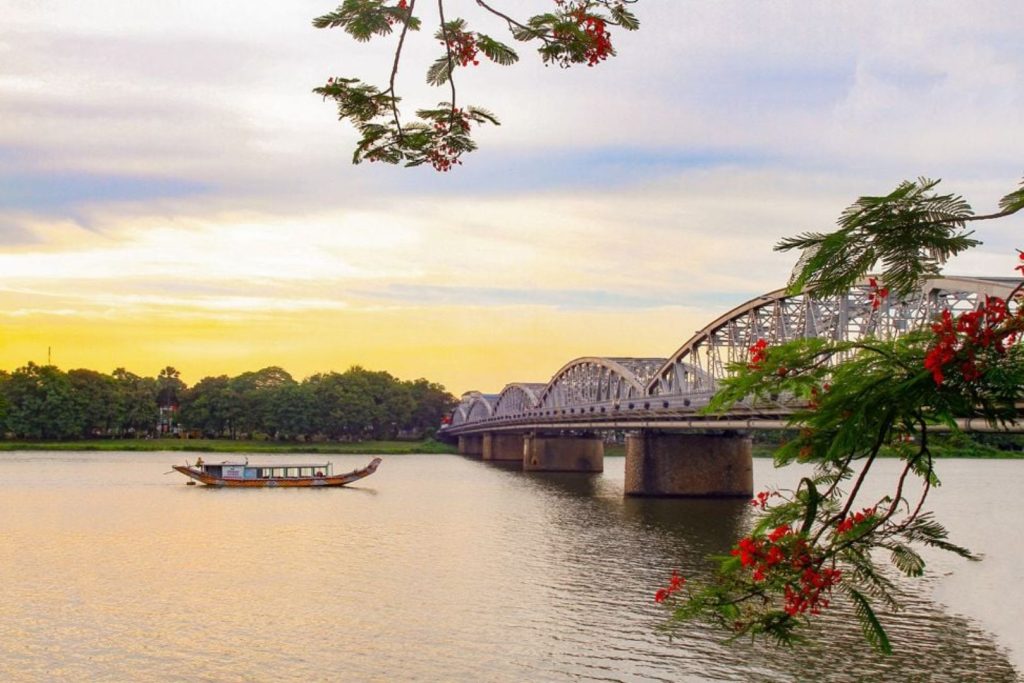
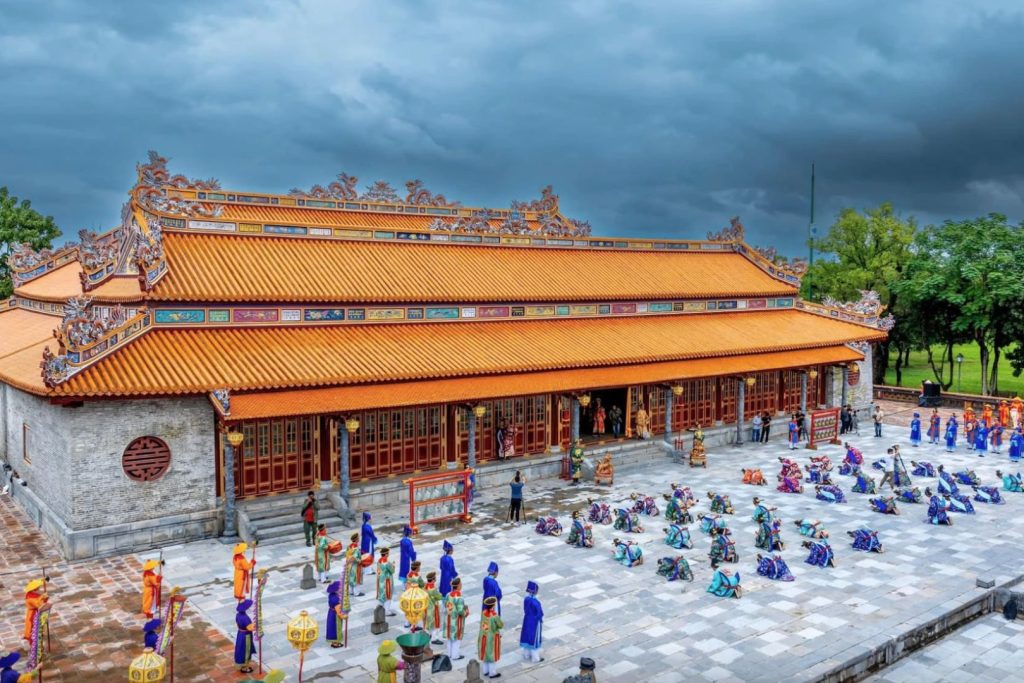
Thai Hoa Palace
Located within the Hue Imperial City complex, Thai Hoa Palace is a pinnacle of grand and majestic architecture. It once was the setting for many important events, such as the grand court ceremonies and coronation rites of the Nguyen emperors. Therefore, a visit to Thai Hoa Palace is an essential experience for any Hue travel plan, helping you to better understand the power and culture of the Nguyen Dynasty.
Handy Tips for a Perfect Hue Travel: Accommodation and Cuisine
To fully enjoy An Dinh Palace and other Hue destinations, keep these accommodation and food tips in mind.
Choosing the Ideal Base for Your Hue Travel
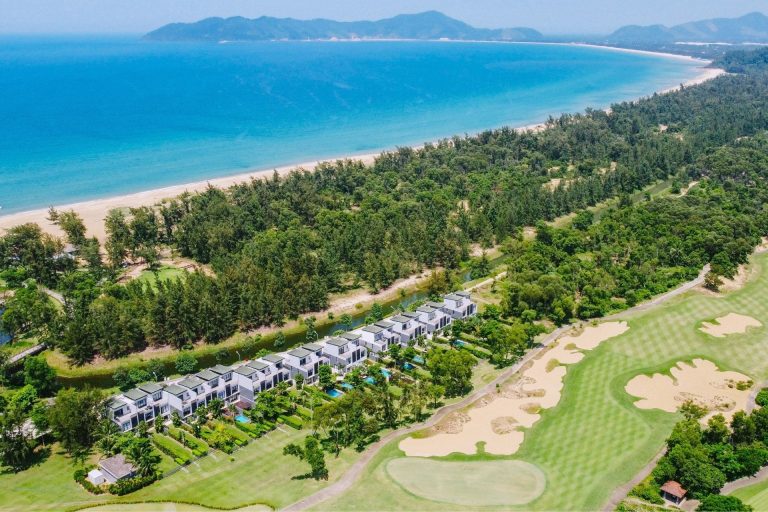
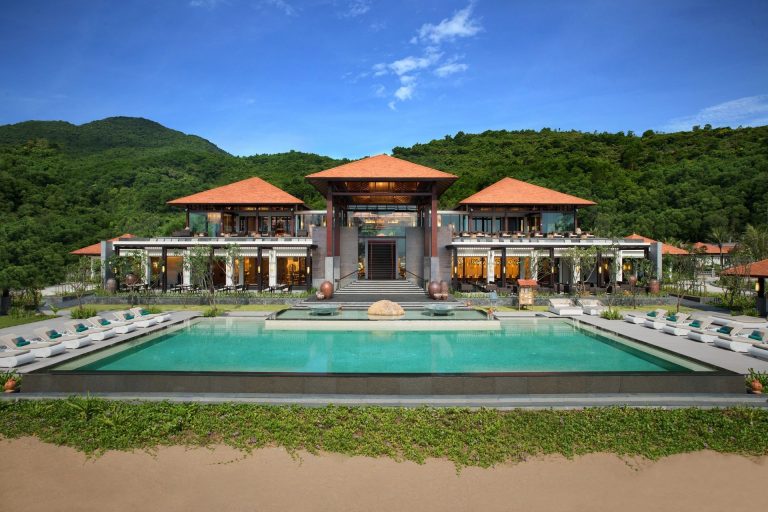
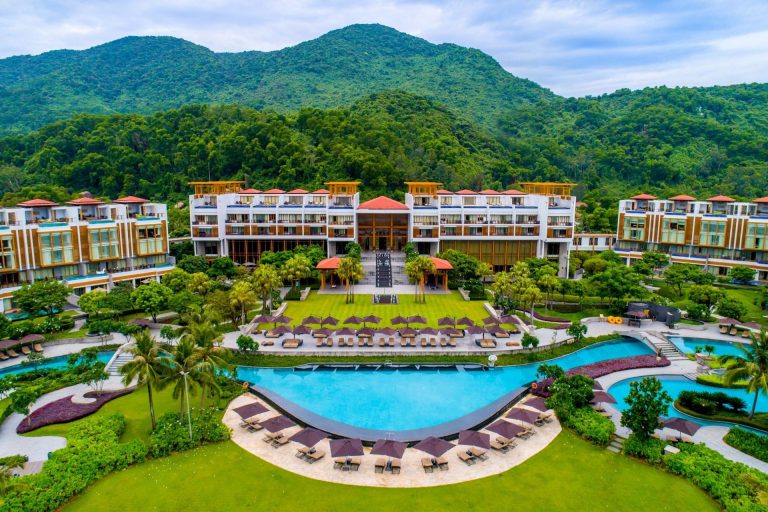
Not far from the city centre, Laguna Lăng Cô is the ideal retreat for visitors who wish to enjoy a perfect blend of nature, comfort, and class.
Situated on the stunning Lăng Cô Bay, Laguna Lăng Cô features a system of 5-star hotels, resorts, and luxury villas suitable for everyone from couples to families and groups of friends. The resort also provides door-to-door transfers from the airport and Hue city centre. Furthermore, you can book bespoke tour packages with a private car, guide, and a flexible itinerary.
With its world-class facilities, attentive service, and diverse amenities including a spa, golf course, restaurants, and beach activities, Laguna Lăng Cô promises to be the perfect complement to your Hue travel journey.
Discover the Quintessence of Hue Cuisine
Hue’s cuisine distinguishes itself through its sophistication and the meticulous care taken in preparation and presentation. Whether it’s a royal dish or a humble local speciality, each one has its own unique character.
For instance, you can start your day with a steaming bowl of bún bò Huế (spicy beef noodle soup), fragrant with lemongrass and chilli. Alternatively, you might savour some bánh bèo, bánh nậm, and bánh lọc (types of steamed rice cakes), which are often arranged as skilfully as a work of art.
For lunch, try cơm hến (clam rice), a rustic dish bursting with spicy, salty, sweet, and nutty flavours. And don’t forget to enjoy nem lụi (lemongrass pork skewers), bánh khoái (crispy pancakes), or chè Huế (sweet soup) in the afternoon to fully appreciate the diverse palate of old Hue.
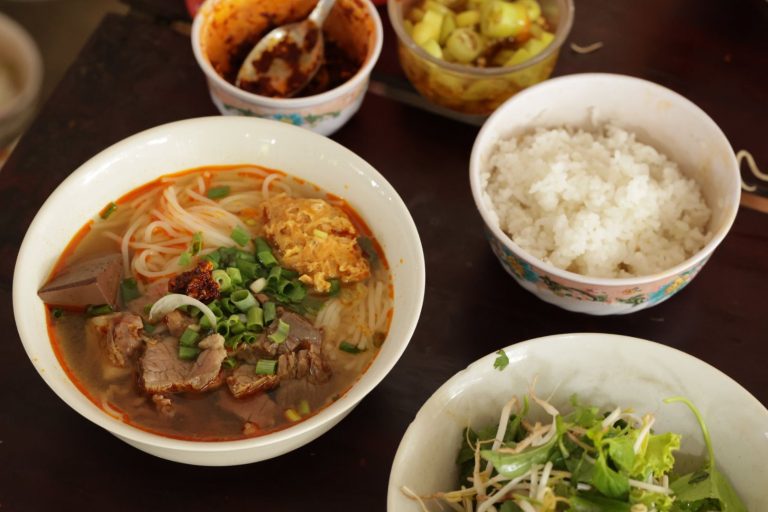
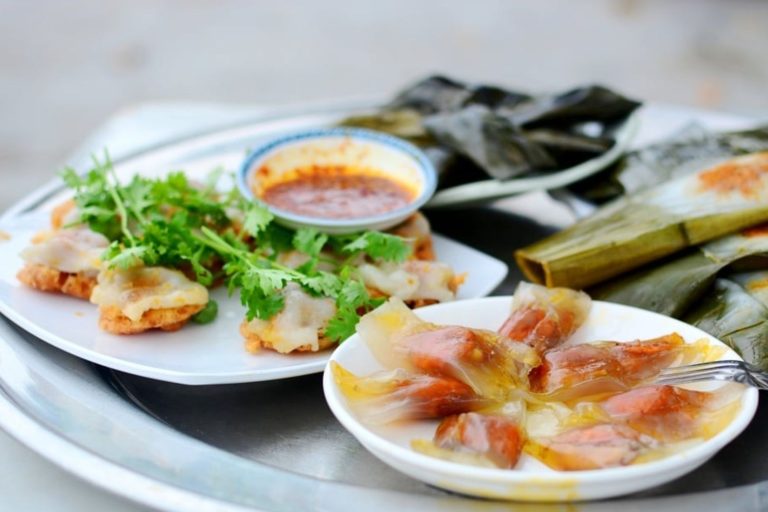
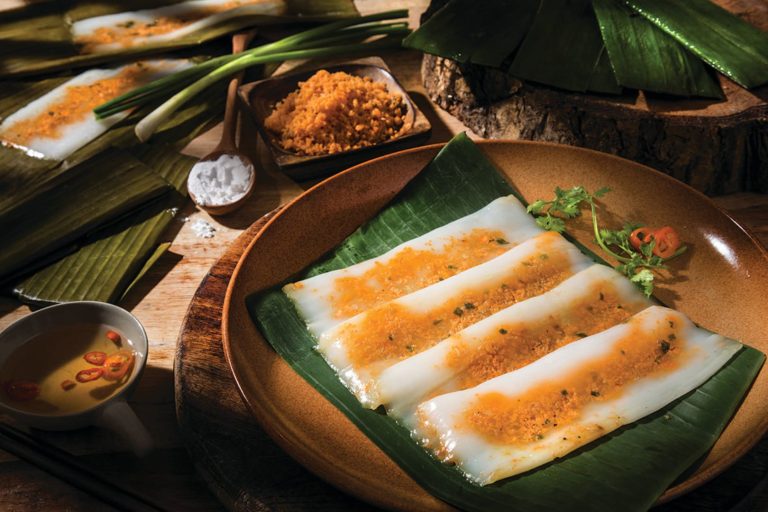
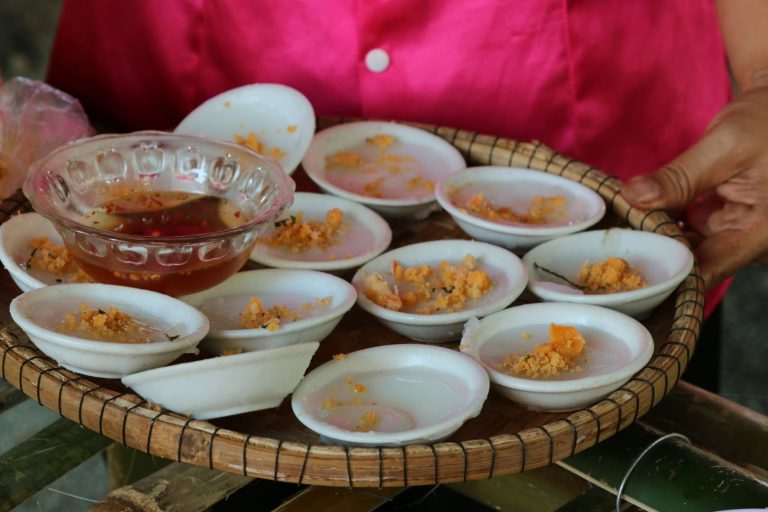

Important Notes for Hue travel and Visiting An Dinh Palace
To ensure your experience is enjoyable and smooth, please consider the following:
- Plan Your Journey: Researching your route before you set off will help you travel more conveniently and save time.
- Appropriate Attire: When visiting historical and cultural sites, please choose respectful and modest clothing. The traditional áo dài is also an excellent choice.
- Photography: Currently, the palace does not permit visitors to use professional cameras inside An Dinh Palace. Please be mindful of this to avoid being reminded.
- Maintain Cleanliness: Always be conscious of keeping the area clean. Do not litter within the monument’s grounds.
- Protect Artefacts: Please do not touch, move, or damage any of the artefacts or furniture within the palace.
Conclusion
An Dinh Palace is not just a unique architectural work; it is also a witness to a golden era of the Ancient Capital. By visiting, you will experience the essence of Hue’s culture – ancient and contemplative, yet full of charm. And if you wish for your Hue travel experience to be truly complete, don’t forget to spend some time relaxing at Laguna Lăng Cô – a place where nature, culture, and true relaxation harmonise.
